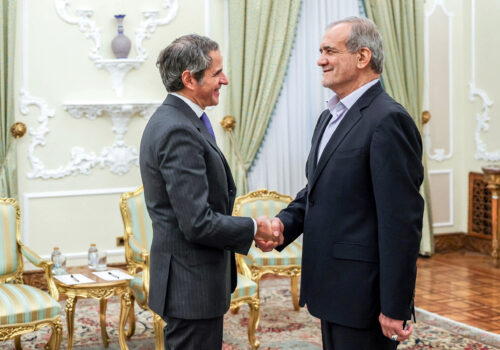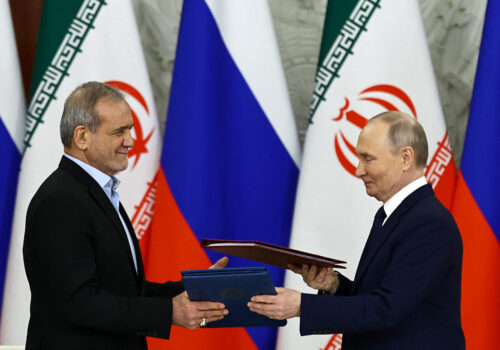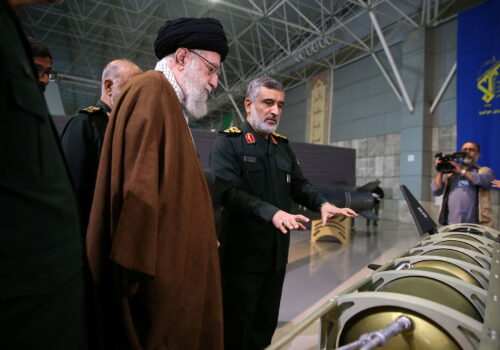The stage is set for a US-Iran showdown—not a deal
There has been a flurry of speculation about possible US diplomacy with Iran since US President Donald Trump began his second term.
After having withdrawn from the 2015 Joint Comprehensive Plan of Action (JCPOA) during his first term, Trump has since expressed an interest in a negotiated settlement with Tehran. But with all deals, the details matter. And while it is true that the Trump administration has not yet given its blessing to Israel for military strikes against Iran—as US intelligence reportedly portends—it was unrealistic to expect such a move from Trump as the opening act of his presidency. Trump needed time to build his team, formulate a policy, and secure international legitimacy and support for military action should it become necessary. The third task requires leaving open a lane for diplomacy to make it possible to blame Tehran should negotiations fail and to secure political support from US allies and partners.
Right now, signs indicate that the United States and Iran are headed towards confrontation, not a successful diplomatic outcome.
The Islamic Republic has not yet softened its position on the nuclear file, even after being weakened by a series of killings of leaders across its proxy network and by the degrading of a chunk of its air defenses and missile capacities. While Iranian decisionmakers have recognized the reality that the 2015 text of the JCPOA is long dead, they have clung to the vision of resurrecting a new deal premised on the basic bargain of temporary nuclear constraints in exchange for sanctions relief, using the JCPOA as a reference point or framework.
Some Iranian officials have taken to the airwaves to hint that there may be willingness to discuss nonnuclear concerns, but those who are the real decisionmakers on these issues—the supreme leader and commanders of the Islamic Revolutionary Guard Corps (IRGC)—have shunned talks over its missile and drone programs and other regional files. Their stances speak louder than the propagandists trying to give an impression to Western constituencies and others that such fundamental change is possible. History has shown that it is not.
SIGN UP FOR THIS WEEK IN THE MIDEAST NEWSLETTER
In February, the supreme leader himself delivered public remarks warning against negotiations with the Trump administration: “One shall not negotiate with a government like this,” he said. “Negotiating is unwise, unintelligent, not honorable.” Already this has triggered hardened rhetoric from Iranian officials, such as President Masoud Pezeshkian, who had previously made more conciliatory comments towards the Trump administration. Since Khamenei’s speech, the Pezeshkian administration has experienced further headwinds with the impeachment of Economy Minister Abdolnaser Hemmati as well as the resignation of Vice President for Strategic Affairs Javad Zarif, who has long been seen as the face of the Islamic Republic’s engagement with the United States.
But Khamenei’s warning last month was not the sweeping ban he laid down in September 2019, when he said, “the policy of maximum pressure on the Iranian nation is of little importance, and all the officials in the Islamic Republic unanimously believe that there will be no negotiations at any level with the United States.” The Islamic Republic under Khamenei will likely never truly walk away completely from the negotiating table, as its political weaponization is a valuable tool to buy time for the regime and divide the United States from within and from its allies. This does not necessarily mean there will be direct and public diplomacy with the Trump administration at this juncture. However, Khamenei’s latest comments seem to leave some room for diplomacy in that they do not necessarily rule out indirect discussions. Such discussions could take place through various channels of communication that Tehran has long maintained with Washington, including through Arab regional interlocutors and European governments. Russia has also reportedly agreed to serve as an intermediary. Still, the obstacles are significant.
For now, on substance, Iran and the United States are talking past each other about “deals.” Iran is still speaking in the language of the JCPOA. But US officials appear to have something different in mind. In a recent interview, Trump publicly disavowed the JCPOA formula, complaining about its short-term duration. This was followed by his national security advisor expressing a willingness to talk to Iran as long as Tehran wants to give up its entire nuclear program. The US secretary of state hinted at a similar demand, noting that in the past, “efforts that Iran has undertaken diplomatically have been only about how to extend the time frame” for its nuclear program and to continue to enrich, sponsor terrorism, build long-range weapons, and “sow instability throughout the region.”
Trump’s National Security Presidential Memorandum-2 (NSPM-2) included related pledges, vowing to “deny Iran all paths to a nuclear weapon and end the regime’s nuclear extortion racket.” NSPM-2 also employed mandatory language stating that the US ambassador to the United Nations will “work with key allies to complete the snapback”—or restoration—”of international sanctions and restrictions on Iran.” This language evokes past US demands for zero enrichment or reprocessing in Iran, which the first Trump administration endorsed. Triggering snapback would also restore previous UN Security Council resolutions, inked before the 2015 JCPOA, which included demands for Iran to suspend “all enrichment-related and reprocessing activities . . . and work on all heavy-water related projects.”
NSPM-2 likewise declared that it is US policy that “Iran be denied a nuclear weapon and intercontinental ballistic missiles,” among other measures to counter Iran’s malign behavior beyond its nuclear program. These US positions are reminiscent of the 2003 Libya disarmament deal, in which the country pledged to dismantle its weapons of mass destruction programs, including nuclear, and to adhere to the Missile Technology Control Regime. However, this is a fundamentally different paradigm from the JCPOA, which allowed Iran to enrich uranium up to 3.67 percent purity and did not touch its missile program.
In fact, Iran’s supreme leader has warned that US officials “intend to systematically reduce Iran’s nuclear facilities, similar to how they did with a North African country”—a hint at Libya—”ultimately leading to the shutdown of Iran’s nuclear industry.” In 2011, Khamenei (referring to Libyan dictator Muammar Ghaddafi) said that “this gentleman wrapped up all his nuclear facilities, packed them on a ship and delivered them to the West and said, ‘Take them!’” He added, “Look where we are, and in what position they are now.” In 2023, after talks about reviving the JCPOA stalled, Khamenei reiterated that “there is nothing wrong with the agreement [with the West], but the infrastructure of our nuclear industry should not be touched.”
Despite forty-six years of failed diplomacy, outside observers have been insisting Iran is ripe for a durable diplomatic arrangement with the United States. Some supporters of negotiations with Iran have also been wishcasting that Trump suddenly adopted the Obama administration’s Iran policy based on an overreading of the new president’s rhetoric and the absence of certain officials, such as former US Secretary of State Mike Pompeo who took a hardline stance, from the policymaking process. But this is a false narrative, one that even some Islamic Republic officials like to promote while arguing that Trump was suckered into an Iran policy that was not his own, despite him expressing disapproval of the JCPOA during his first presidential campaign, well before his national security team was assembled.
There is no public evidence to date that the maximum Tehran is prepared to give—a JCPOA-style arrangement—will meet the minimum the Trump administration is prepared to accept. If current positions hold, this sets the stage for a showdown, not a deal, in the near term, necessitating the development of a robust pressure architecture to further sharpen Tehran’s choices.
Jason M. Brodsky is the policy director of United Against Nuclear Iran (UANI). His research focus includes Iranian leadership dynamics and Iran’s military and security apparatus. He is on X @JasonMBrodsky.
Further reading
Wed, Nov 20, 2024
2025 will be a decisive year for Iran’s nuclear program
IranSource By Danny Citrinowicz
Diplomatic deadlines and regional factors will force Iran to decide soon whether to strike a deal or seek a nuclear weapon. Either choice will have major ripple effects.
Sat, Jan 18, 2025
A Russian-Iranian inaugural gift for Trump
Inflection Points Today By Frederick Kempe
The new “comprehensive partnership agreement” between Moscow and Tehran is the latest example of greater coordination among the “axis of aggressors.”
Fri, Oct 25, 2024
Israel’s attack in Iran means full-scale war is closer than ever. Here’s what Iran is thinking now.
New Atlanticist By Danny Citrinowicz
Iran's leaders fear a full-scale war with Israel, but can they absorb this attack without retaliating and thus be exposed to future attacks?
Image: FILE PHOTO: A display featuring missiles and a portrait of Iran's Supreme Leader Ayatollah Ali Khamenei is seen at Baharestan Square in Tehran, Iran September 27, 2017. Picture taken September 27, 2017. Nazanin Tabatabaee Yazdi/TIMA via REUTERS ATTENTION EDITORS - THIS IMAGE WAS PROVIDED BY A THIRD PARTY/File Photo


